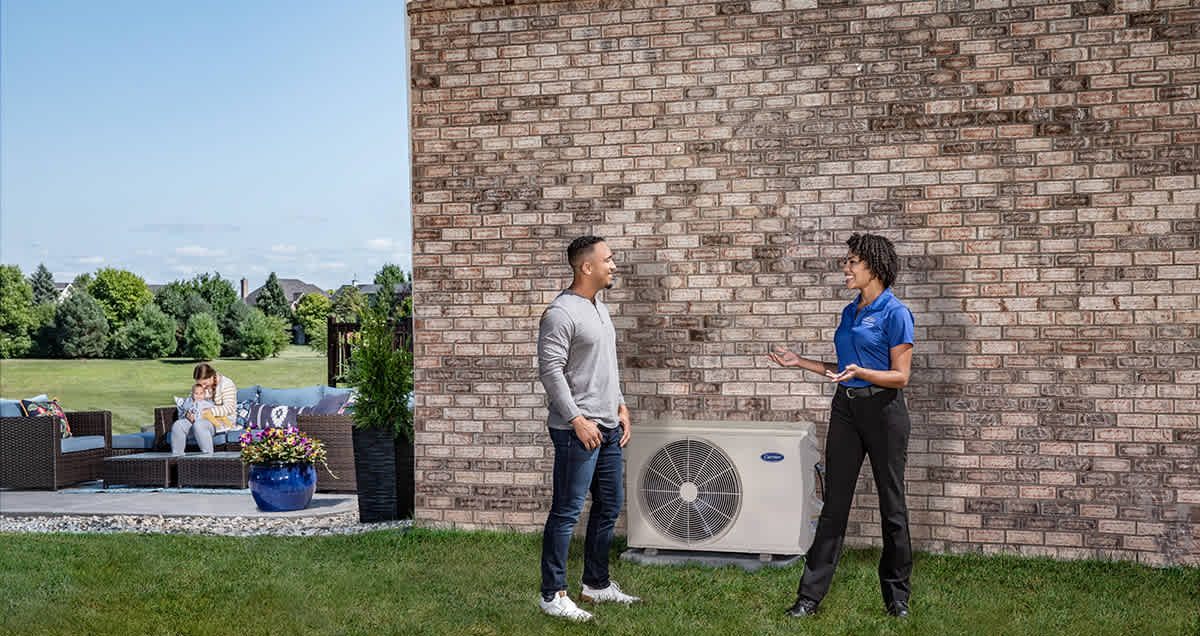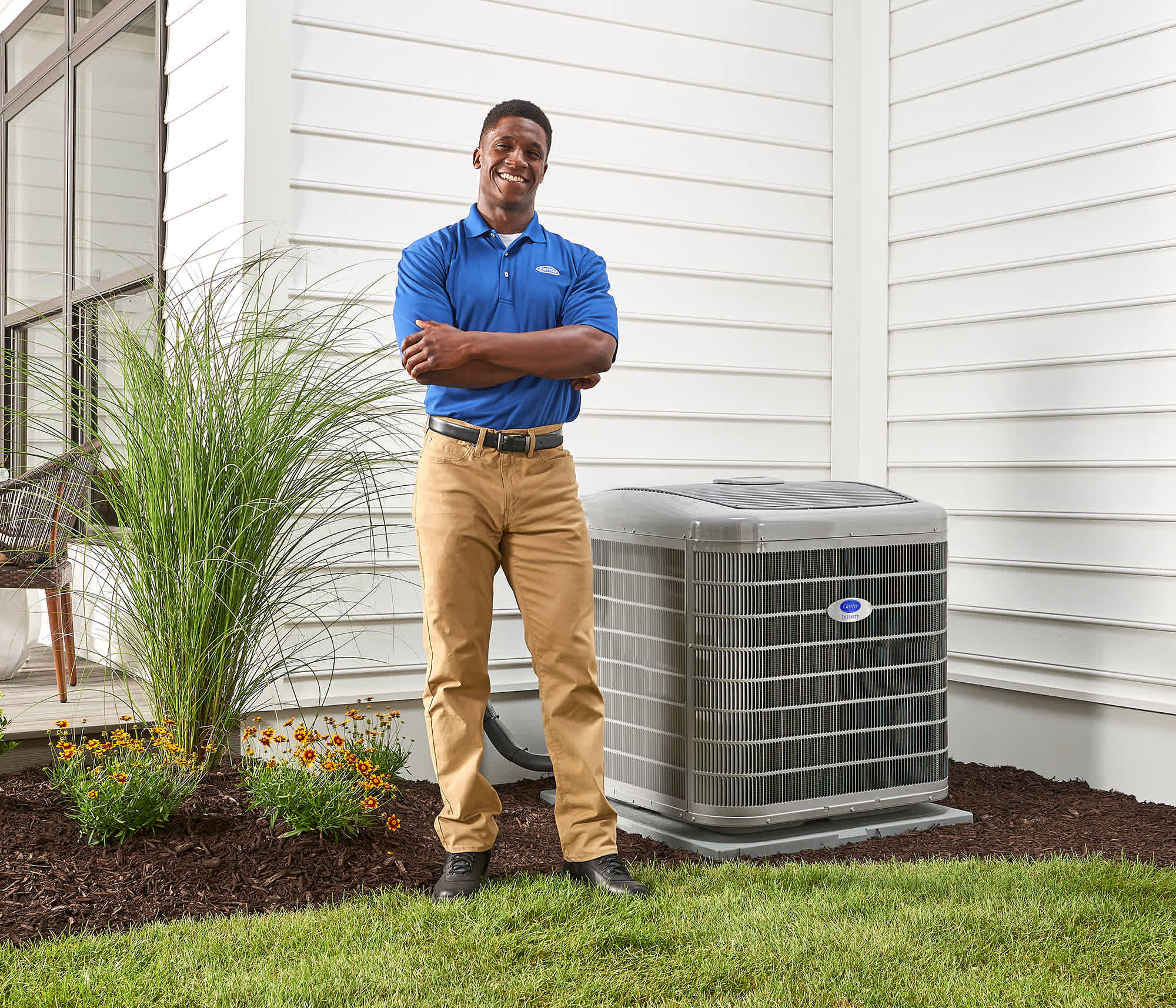How Do Air Conditioners Work?
By Travis Baugh
On July 17th, 1902, Willis Carrier invented the first modern air conditioning system . Carrier’s invention helped give rise to numerous industries that continue to power our economy today. Today’s “modern” cooling systems still operate on the same basic principles, providing comfortably chilled air to people inside. So, how do air conditioners work?

Air conditioners come in a variety of shapes and sizes, but they all operate on the same basic premise. An air conditioner provides cold air inside your home or enclosed space by actually removing heat and humidity from the indoor air. It returns the cooled air to the indoor space, and transfers the unwanted heat and humidity outside.
A standard air conditioning system works by using a specialized chemical called refrigerant, and has three main mechanical components: a compressor, a condenser coil and an evaporator coil. These components work together to quickly convert the refrigerant from gas to liquid and back again. This process involves five steps:
- The compressor raises the pressure and temperature of the refrigerant gas and sends it to the condenser coil where it is converted to a liquid.
- Then the refrigerant travels back indoors and enters the evaporator coil. Here the liquid refrigerant evaporates, and cools the indoor coil.
- A fan blows indoor air across the cold evaporator coil where the heat inside the home is absorbed into the refrigerant.
- The cooled air is then circulated throughout the home while the heated evaporated gas is sent back outside to the compressor.
- The heat is then released into the outdoor air as the refrigerant returns to a liquid state.
This cycle continues until your home has reached the desired temperature.

This drawing, the result of Willis Carrier’s groundbreaking design, was submitted to Sackett & Wilhelms on July 17, 1902 and provided the basis for the invention that would change the world, the first modern air conditioning system.
How Air Conditioning Works To Cool Your Home
Many homes in North America rely on split-system air conditioners, often referred to as “central air.” Central air conditioning systems include a number of components and do more than just cool the air inside. They also can control humidity, air quality and airflow within your home. So before we answer the question of how do air conditioners work, it will be helpful to know what makes up a typical system.
What is a Central Air Conditioning System?
A typical air conditioning system, often referred to as “a central air conditioning system” or “split-system air conditioning”, normally includes the following:
- a thermostat that controls system operation
- an outdoor unit that houses a fan, condenser coil and compressor
- an indoor unit (typically either a furnace or fan coil) that houses the evaporator coil and fan to circulate the cooled air
- copper tubing that allows refrigerant to flow between the indoor and outdoor units
- an expansion valve the regulates the amount of refrigerant going into the evaporator coil
- ductwork that allows air to circulate from the indoor unit out to the various living spaces and back to the indoor unit

Source: U.S. Department of Energy - Energy Saver 101 Infographic
In its most basic description, the air conditioning process involves two actions that occur simultaneously, one inside the home and one outside the home.
- Inside the home (sometimes referred to as the “cold side” of the system), warm indoor air is cooled as it blows across a cold cooling coil full of refrigerant. The refrigerant is first expanded to drop the pressure and then heat from indoor air is absorbed into the refrigerant as the refrigerant turns from liquid to gas. The cooled air is distributed back to the house.
- Outside the home (sometimes referred to as the “hot side” of the system), the refrigerant gas is compressed before entering a large coil in the outdoor unit. Heat is released outside as the refrigerant turns back to a liquid and a large fan pulls outdoor air through the outdoor coil rejecting the heat absorbed from the house.
The result is a continuous cycle of heat and humidity being removed from indoor air, cool air returning to the home, and heat and humidity exiting the home.
How Does AC Work -- In More Detail
Now that you have a basic understanding of how air conditioners work, let’s dig a little deeper and describe the entire AC cooling process.
- The thermostat, which is typically mounted on a wall in a central location within the home, monitors and controls the temperature of the indoor air.
- The AC cooling process starts when the thermostat senses the air temperature needs to be lowered and sends signals to the central air conditioning system components both inside and outside the home to start running.
- The fan from the indoor unit pulls hot air from inside the house through return air ducts. This heat from the air passes through air conditioner filters where dust, lint and other airborne particles are collected.
- The filtered, warm indoor air then passes over cold evaporator coil. As the liquid refrigerant inside the evaporator coil converts to gas, heat is absorbed from the indoor air into the refrigerant, thus cooling the air as it passes over the coil.
- The indoor unit’s blower fan then pumps the chilled air back through the home’s ductwork out into the various living areas.
- The refrigerant gas leaves the home through a copper tube and passes into the compressor in the air conditioner unit outside.
- Think of the compressor as a large electric pump. The compressor pressurizes the refrigerant gas and sends the refrigerant into the outdoor unit’s condenser coil.
- A large fan pulls outdoor air through the condenser coil, allowing the air to absorb heating energy from the home and release it outside.
- During this process, the refrigerant is converted back to a liquid.
- It then travels through a copper tube back to the indoor unit where it passes through an expansion device, which regulates the flow of refrigerant into the evaporator coil.
- The cold refrigerant then absorbs more heat from the indoor air and the cycle continues.

HOW DIFFERENT TYPES OF AIR CONDITIONERS WORK
As you can see, asking the question “how do air conditioners work” can lead to a very simple or very complicated explanation. It’s the same with describing types of air conditioners. And because indoor living spaces come in a variety of shapes and sizes, from today’s new tiny homes, to 30,000 square foot estates, residential air conditioning systems are also available in different styles and configurations to match. There are three primary types – split-system air conditioner, packaged air conditioner, and ductless air conditioner. Each has its own specialized uses, but they all essentially do the same thing – make it cool inside your home. The best air conditioner for you depends on your geographical location, the size and physical limitations of your home, and the way you use it.

Split-System Air Conditioner
Split-system offer the most common answer to the question, “what is central air?” These systems include both an indoor unit and an outdoor unit. The indoor unit, typically a furnace or a fan coil, includes the evaporator coil and blower fan (air handler) that circulates air throughout the home. The outdoor unit holds the compressor and the condenser coil.
Split-system air conditioners provide a variety of options, including basic single-stage systems, quieter and more efficient two-stage systems, and the quietest, most energy-saving inverter air conditioners. A split system air conditioner offers consistent, reliable temperature control to the entire home. And, because the air conditioning system uses filters in the indoor air handler, it can clean your air while it cools it. Learn more about what is a split air conditioning system?
Packaged AC System
Packaged systems are all-in-one solutions that also answer the question “what is central air?” Packaged systems contain the evaporator coil, blower fan, compressor and condensing coil all in one unit. They work well when there isn't enough space in an attic or closet for the indoor unit of a split-system air conditioner. They are also a good choice in areas where rooftop installations are preferred. Like split systems, packaged systems pull warm air from the home, through return air ducts, into its evaporator coil section. The air passes over the evaporator coil and the cooler air returned back to the home through supply air ducts. And, as with a split system, the unwanted heat is released to the outside through the condenser coil.
Packaged air conditioning systems also offer a variety of options to provide better energy efficiency. They are available in two-stage systems and single-stage systems. Higher efficiency models include multi-speed blower fans. In the United States, packaged systems are most common in the south and southwest areas of the country.
Ductless AC System
Ductless systems are not considered to be central air systems because they deliver cooling to specific, targeted areas within the home. They require less invasive installation because, as their name suggests, they don't rely on ductwork to distribute chilled air. Like split systems, ductless air conditioning systems include an outdoor unit and at least one indoor unit, connected by copper refrigerant tubing. In a ductless system each indoor unit is designed to provide cool air only for the room in which it is installed. The indoor unit can be installed on a wall, in the ceiling, or on the floor. Some ductless systems can include multiple indoor units connected to one outdoor unit. Regardless of the number of indoor units, the operation is similar to a split system. The indoor unit contains an evaporator coil and blower fan to pull warm air from the room, across the cool evaporator coil, then return the cooler air back into the room. Refrigerant runs through the copper tubing to the outdoor unit where the compressor and condenser coil are located. Heat from inside is released through the outdoor condenser coil. Refrigerant returns to the indoor unit, and the cycle continues.
These flexible systems deliver pinpointed comfort in the areas where indoor units are placed. They also act like a zoning system by offering individual temperature control over each separate room. For example, if you want a cooler home office but a warmer bedroom, install a ductless unit in each room. Now you can set different temperatures in each area depending on your comfort needs.
Regardless of which type of system works for your home or property, knowing the answer to “how do air conditioners work?” can help you choose a system for AC installation that makes the most sense. And, it will allow you to better understand the choices your HVAC contractor is presenting. Contact your local Carrier dealer today to schedule an appointment and get a quote for central air conditioner price.

Frequently Asked Questions About How Do ACs Work
- Learn How to Change Air Conditioner Filters
- Find out How Do Air Conditioners Work
- What is a Split Air Conditioning System?
- Help with Air Conditioner Fan Not Working
- Common reasons for Air Conditioner Not Cooling House
- Learn All About Air Filters
- Find out if Air Conditioning is Bad for the Environment
- Learn about Air Conditioner Coil Cleaning
- Factors and variables - How Long Do Air Conditioners Last?
- Find out What is Central Air and How Does It Work?
- Read about central air conditioner prices
- Read about How Often to Change Air Conditioner Filters
- What Size Air Conditioner Do I Need?
- What is the Best Air Conditioner Temperature?
- What is a heat pump vs air conditioner?

